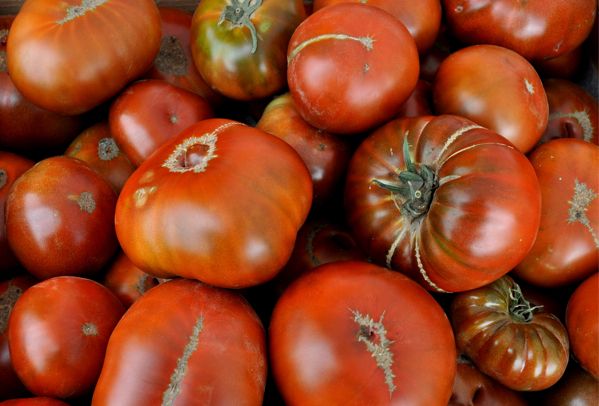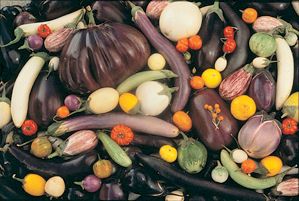Discovering Heirlooms

Discovering Heirloom Tomatoes
– A guest post by Elizabeth Bernard Higgs
Meet the Paul Robeson Tomato.
I first saw this purple beauty (named after the great American singer and actor) while browsing through a specialty food store. I had never seen anything like it in my life. You see, I am the product of a supermarket upbringing. My mother was and is a wonderful cook and fed my sisters and me tasty nutritious meals made from scratch all my childhood, but everything we ate came from the grocery store. So my experiences with tomatoes were limited to the hybrids that had been developed to ripen at the same time, to have thick skin, and to turn uniformly red, the latter mutation being the primary culprit in the crime of rotten-tasting tomatoes. Tomatoes were one of my least favorite foods.
I didn’t know what to think of this purple tomato I found. I mean, it was purple! But it just looked and felt so perfectly ripe that I decided to give it a chance, and I took it home. As soon as I sliced it open, I could smell the delicious aroma, and when I took a bite, I discovered a rich, smoky sweetness that I had no idea was even remotely possible in a tomato. I was hooked. And so began my adventures with heirloom tomatoes.
I was stunned to discover that tomatoes come in all shapes and sizes, and in addition to red and purple, there are pink, yellow, green, orange, and even white varieties! It wasn’t long before I was scouting out seeds to buy, and that’s when I discovered that there are literally millions of varieties of species of fruits and vegetables being grown on a small scale around the world.
How did all these varieties develop? They all started as wild plants. But from these wild plants, farmers and gardeners, who, for millennia, fed their families from their own backyards, began to select their plants (by saving seeds from the best plants) for hardiness, yields, and resistance to pests and disease. In doing so, a gardener in Argentina creates an heirloom particularly suited to its location and climate, while a gardener growing the same species in Minnesota ends up with an heirloom that looks nothing like its Argentinian cousin. One species of plant can produce an amazing variety of fruit! This photo is an outstanding representation of the Art and Beauty and Vibrancy of God’s Creation. These are ALL eggplants!

How fortunate we are to be the recipients of such an incredible living legacy! People all around the world, through love and nurture and necessity, have given to us a variety of foods that is almost unbelievable. Let us not abandon this legacy, but instead pass it on to our own children, adding our own little bit of flavor to the mix.
The World’s Seed Supply
While flavor and curiosity might be the primary reason people begin their adventures in heirloom gardening and seed saving, another, more ominous reason has prompted widespread renewed interest in heirlooms.
Beginning in 1980, when the Supreme Court ruled that living beings may be patented, giant agri-chemical companies such as Monsanto, Dupont and Syngenta have been buying up hundreds of seed companies in the United States with the sole purpose of limiting varieties of seeds available to the public.
Even if Monsanto alters only a single gene in a plant, out of tens of thousands, the company may be granted a patent, and that seed becomes unavailable to farmers and gardeners. The only version of that variety available for purchase will be the genetically modified version of the plant. In most cases, the varieties simply disappear. “The United Nations Food and Agriculture Organization (FAO) estimates that about three-quarters of the original varieties of agricultural crops have been lost from farm fields since 1900.” A century ago there were 15,000 varieties of apples growing in the United States. But in 2013, only eleven varieties are regularly available in grocery stores, and the bland Red Delicious variety accounts for 60% of apples grown in the United States.
This trend is accelerating at a rapid pace as giant firms gain greater and greater control over our seed stocks, accompanied by the inevitable rise in prices. There is a high premium to be paid for GM seeds. Farmers growing Monsanto’s SmartStax variety are paying four times more for their corn seed than those using conventional seed a decade ago, and from 1995 to 2011 the price of cotton seed increased 516%.
Monsanto, Dupont, and Syngenta control 53% of the entire global seed market. The top ten seed companies worldwide control 74% of the seed market, and they are using patent protection to limit the availability of seeds, virtually ensuring the loss of thousands of varieties.
Agri-chemical firms place restrictions on how their seeds may be used, for instance, banning the saving of seeds. Perhaps the most egregious restriction: purchasers are explicitly forbidden from doing any research on the crops grown from these seeds, without the permission of the seed maker. This permission is granted only with many strings attached, and certain types of research are suppressed entirely.
Plants that have been modified to withstand Monsanto’s Round-Up Weed Killer are sprayed with huge amounts of glyphosate, and growing resistance to the chemical by the very weeds it is meant to kill resulted in 2008 in a 26% greater use of pesticides on GM crops than on conventional crops. When you consider that in 2010, 86% of corn and 93% of soybeans were genetically modified varieties, this situation entails that hundreds of millions of pounds of additional pesticides were dumped onto food crops in this country, pesticides that find their way into our lakes, streams, rivers, water supplies and, yes, our food. These companies sell seeds in order to sell the poison that goes along with them.
There is no scientific consensus on whether these plants are safe for us to eat, because not enough published research exists to paint a clear picture of the effects of such high rates of pesticide use or of the introduction of glyphosate and other poisons into the seeds themselves.
The Importance of Plant Diversity
What has developed from this concentration of seed ownership in the hands of so few companies is an agricultural monoculture in which very few varieties of plant species are grown, making these species much more vulnerable to destruction by pests and diseases. The very thing that has allowed the eggplant to be grown around the world and to produce fruit with such a wide variety of shapes and sizes and colors IS its genetic diversity. It is not fear mongering to state that a narrowing gene pool puts living organisms at greater risk for extinction; it is simply a statement of fact. One variety of a fruit might be vulnerable to a certain fungus, whereas other varieties in the same species are not threatened by it, and so the species survives. The smaller and smaller the number of varieties of agricultural crops shrinks, the closer we come to the possibility of complete crop failure.
We can do our part to keep our food abundant. Grow tried and true heirloom varieties. When your plants thrive, SAVE YOUR SEEDS! These heirloom varieties represent the storehouse of thousands of years of human sweat and labor and love. They are a living legacy from our ancestors, and they are the future of the real food movement. We should treasure this legacy.
It is true that small-scale farming and backyard gardening can never feed the seven billion people who live on this planet, and we should be grateful to agri-businesses that have made large-scale agriculture available to regions of the world that have previously experienced frequent periods of famine, but until these same businesses come to see that limiting our seed supplies and poisoning our food is unnecessary and detrimental to our planet, our only recourse is to limit our exposure to these frankenfoods whenever possible. Heirloom plants are the very best option available to us.
One of the best outlets for heirloom seeds is the Baker Creek Heirloom Seed Co. This family-run enterprise offers 1,400 varieties, all pure and natural, with no GM seeds. Baker Creek Heirloom Seeds are available locally at Marsolan Feed and Seed. Owner Harvey Marsolan has decades of experience helping new gardeners master the art of growing. Please visit his store at 316 E. Gibson St. in downtown Covington. He will be more than happy to help you get your garden growing!
Elizabeth Bernard Higgs – February 23, 2013 – Covington, LA